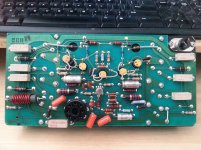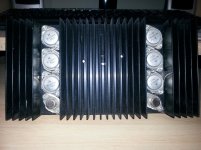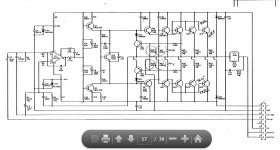Hi all, I have one of these power amps that is experiencing a certain issue. With no load connected to the output, it will swing 36 vac with a clean waveform but as soon as you connect a load, the protection relay kicks in.
Backing down the input level to the point just before relay engagement, I see that the negative waveform is missing and the DC content is about 4 volts.
There are no visible signs of component failure and the DC offset is .005
This seems to be a rare model, I cant find anything on it online but it does seem to be similar to the model 250.
What should I be looking for?
TIA
Backing down the input level to the point just before relay engagement, I see that the negative waveform is missing and the DC content is about 4 volts.
There are no visible signs of component failure and the DC offset is .005
This seems to be a rare model, I cant find anything on it online but it does seem to be similar to the model 250.
What should I be looking for?
TIA
Hi Michael
The 210 / 410 amplifiers had old & newer amplifier modules. They were similar to the 250 but had RCA and Speaker clips. Take a picture of the PCB and TOP side of the heat sink. I do have some old data.
Duke
The 210 / 410 amplifiers had old & newer amplifier modules. They were similar to the 250 but had RCA and Speaker clips. Take a picture of the PCB and TOP side of the heat sink. I do have some old data.
Duke
Hi Michael
The 210 / 410 amplifiers had old & newer amplifier modules. They were similar to the 250 but had RCA and Speaker clips. Take a picture of the PCB and TOP side of the heat sink. I do have some old data.
Duke
Here you go:
Any chance of posting/sending some of that documentation?
Attachments
Michael Take a picture of the top sife of the heatsink. I need to see the power devices.
Duke duke.aguiar@ieee.org
Duke duke.aguiar@ieee.org
Sounds like a resistor gone high somewhere around the outputs and drivers, maybe a duff driver on the negative side. The former should be easy enough to check with a multimeter.
Sounds like a resistor gone high somewhere around the outputs and drivers, maybe a duff driver on the negative side. The former should be easy enough to check with a multimeter.
Can you please clarify "on the negative side".
Usually when the output looks OK without a load the circuitry should be good up to and including the drivers. If the output is bad with a load the problem is in the output stage circuitry.
Craig
Craig
I`m still not having any luck locating a schematic but I`m in the process of testing all the semiconductors and will report back with my findings.
The BGW 250D/E on HiFi Engine should be close to your 210. Yours has TO-39 VAS and bias transistors whereas the 250 has the TO-126 style in those positions. Most of the BGWs are similar except those that Audio1Man designed, the 7000 and 8000 series and maybe others.
Craig
Craig
I forgot to mention make, sure you check and clean those big octal sockets, I've had weird stuff happen with those sockets.
Craig
Craig
Hi Michael
Your module is a late 410A and it is full comp design. It is like the 250D/E with TO5 parts. Later designs used TO126.
DC offset <0.010, no burned parts and the circuit breaker not tripping lead me to this.
From your description of normal sine wave output @ no load and missing negative output with load the Emitter resistors on the PNP are OPEN. The early 0.33 Ohm parts failed OPEN. I removed the supplier as a source. The resistors used fine nichrome wire and opened with overload.
Duke🙂
Your module is a late 410A and it is full comp design. It is like the 250D/E with TO5 parts. Later designs used TO126.
DC offset <0.010, no burned parts and the circuit breaker not tripping lead me to this.
From your description of normal sine wave output @ no load and missing negative output with load the Emitter resistors on the PNP are OPEN. The early 0.33 Ohm parts failed OPEN. I removed the supplier as a source. The resistors used fine nichrome wire and opened with overload.
Duke🙂
I found a 410 schematic and it seems to be very similar to what I have on hand, at least as far as the semiconductor type and count is concerned. Even the power supply measures in at + and -55v.
Octal plugs are nice and clean btw.
Octal plugs are nice and clean btw.
Update
I tested all the semiconductors and resistors including the emitter resistors and everything checked out fine. Because this was done in-circuit, there were a couple of readings that didn't seem right but I used the working module as a reference for confirmation.
After reinstalling the module for further testing, it decided to work 😕 and well, putting out 128w into my 8 ohm load without breaking a sweat. Even though it isnt rated below 8, I dropped the load to 6 ohms where it put out 150w.
Why stop there, lets see what it does into 3 ohms. CLICK goes the protection relay, no more negative signal. Backing the input down to just below the relay engagement threshold, I gave the heatsink a few raps with my screwdriver and saw the negative waveform momentarily reappear. I then started poking around the PC board and was able to recreate the fault condition by applying a little pressure to the lower right corner of the PC board. Although there were no obvious cold joints or broken traces except for maybe the lone diode CR6, I just reflowed all the joints in that quadrant and that seemed to do the trick 🙂, does that sound plausible?
I`ve been cycling the amp at half power, one hour on, half hour off all evening and so far so good. It doesnt object to a 3 ohm load either where it puts out 161w.
I hope I`m not prematurely declaring victory but it would appear that the issue has been solved, many thanks to Duke and all others who graciously chimed in 🙂
I tested all the semiconductors and resistors including the emitter resistors and everything checked out fine. Because this was done in-circuit, there were a couple of readings that didn't seem right but I used the working module as a reference for confirmation.
After reinstalling the module for further testing, it decided to work 😕 and well, putting out 128w into my 8 ohm load without breaking a sweat. Even though it isnt rated below 8, I dropped the load to 6 ohms where it put out 150w.
Why stop there, lets see what it does into 3 ohms. CLICK goes the protection relay, no more negative signal. Backing the input down to just below the relay engagement threshold, I gave the heatsink a few raps with my screwdriver and saw the negative waveform momentarily reappear. I then started poking around the PC board and was able to recreate the fault condition by applying a little pressure to the lower right corner of the PC board. Although there were no obvious cold joints or broken traces except for maybe the lone diode CR6, I just reflowed all the joints in that quadrant and that seemed to do the trick 🙂, does that sound plausible?
I`ve been cycling the amp at half power, one hour on, half hour off all evening and so far so good. It doesnt object to a 3 ohm load either where it puts out 161w.
I hope I`m not prematurely declaring victory but it would appear that the issue has been solved, many thanks to Duke and all others who graciously chimed in 🙂
Attachments
Last edited:
CR6 is just a flyback diode, it wouldn't/shouldn't cause your problem. Just for grins try wiggling the octal plug while it's running since it sort of healed itself. I know I've had problems with those octal plugs on few BGWs I've worked on, it was a real head scratcher the first time I encountered it. Anyways I think BGWs are cool amps and love working on them, I don't think I've done any real major repairs on those versions of the circuit.
Craig
Craig
The octal plugs were among the first components that were looked at. I suspected a possible B+ or B- issue, only a single pin is dedicated for each where the big 750s used 2.
Could the driver have been the culprit?
Could the driver have been the culprit?
I'm sure you would have noticed that when you ran it without a load. Go back to my first reply.
Craig
Craig
- Status
- Not open for further replies.
- Home
- Amplifiers
- Solid State
- BGW 210


